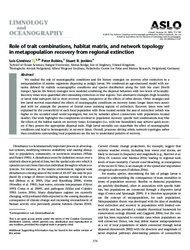Role of trait combinations, habitat matrix, and network topology in metapopulation recovery from regional extinction
DOI: https://doi.org/10.1002/lno.11347
Persistent URL: http://resolver.sub.uni-goettingen.de/purl?gldocs-11858/9321
Persistent URL: http://resolver.sub.uni-goettingen.de/purl?gldocs-11858/9321
Giménez, Luis; Robins, Peter; Jenkins, Stuart R., 2019: Role of trait combinations, habitat matrix, and network topology in metapopulation recovery from regional extinction. In: Limnology and Oceanography, Band 65, 4: 775 - 789, DOI: 10.1002/lno.11347.
 |
Dokument öffnen: |
We studied the role of oceanographic conditions and life history strategies on recovery after extinction in a metapopulation of marine organisms dispersing as pelagic larvae. We combined an age-structured model with scenarios defined by realistic oceanographic conditions and species distribution along the Irish Sea coast (North Europe). Species life history strategies were modeled combining the dispersal behaviors with two levels of fecundity. Recovery times were quantified after simulating extinction in four regions. Two alternative strategies (high fecundity or larval tidal transport) led to short recovery times, irrespective of the effects of other drivers. Other strategies and low larval survival exacerbated the effects of oceanographic conditions on recovery times: longer times were associated with for example the presence of frontal zones isolating regions of extinction. Recovery times were well explained by the connectivity of each focal population with those located outside the area of extinction (which was higher in the so-called small world topologies), but not by subsidies (direct connections with populations located nearby). Our work highlights the complexities involved in population recovery: specific trait combinations may blur the effects of the habitat matrix on recovery times; K-strategists (i.e., with low fecundities) may achieve quick recovery if they possess the appropriate dispersal traits. High larval mortality can exacerbate the effect of oceanographic conditions and lead to heterogeneity in recovery times. Overall, processes driving whole network topologies rather than conditions surrounding local populations are the key to understand patterns of recovery.
Statistik:
ZugriffsstatistikSammlung:
Schlagworte:
marine organismextinction
recovery patterns
simulation
effects of oceanographic conditions
This is an open access article under the terms of the Creative Commons Attribution License, which permits use, distribution and reproduction in any medium, provided the original work is properly cited.

